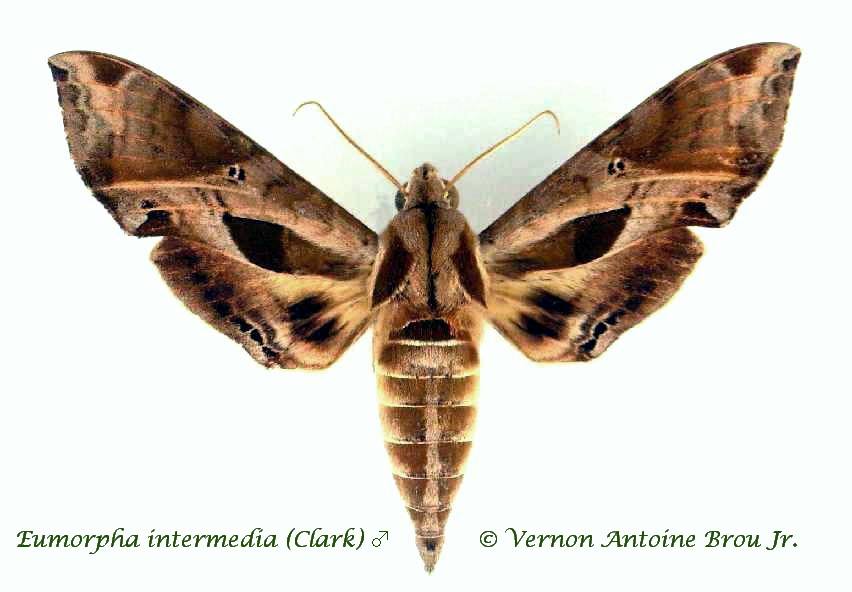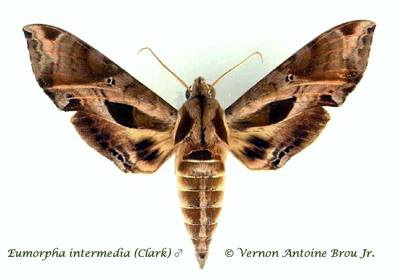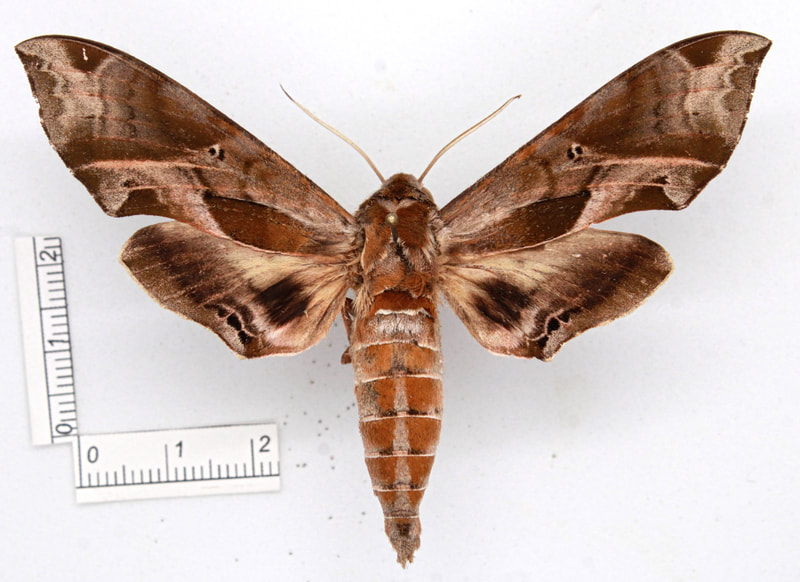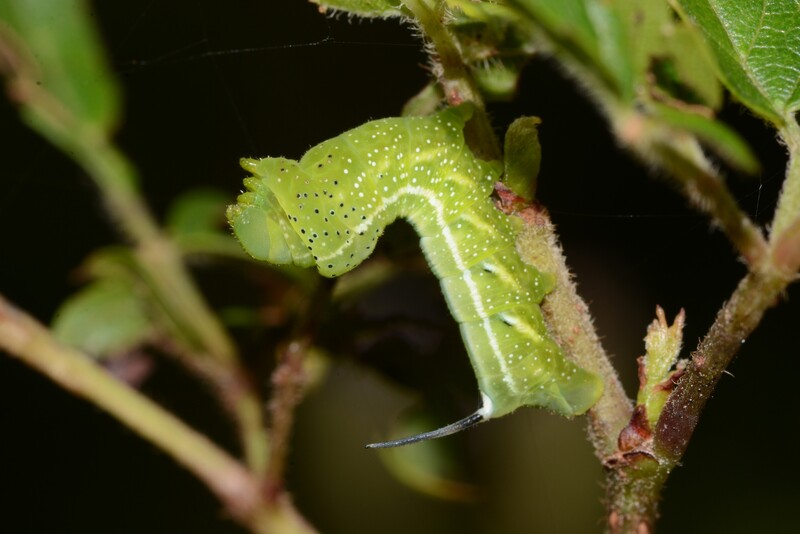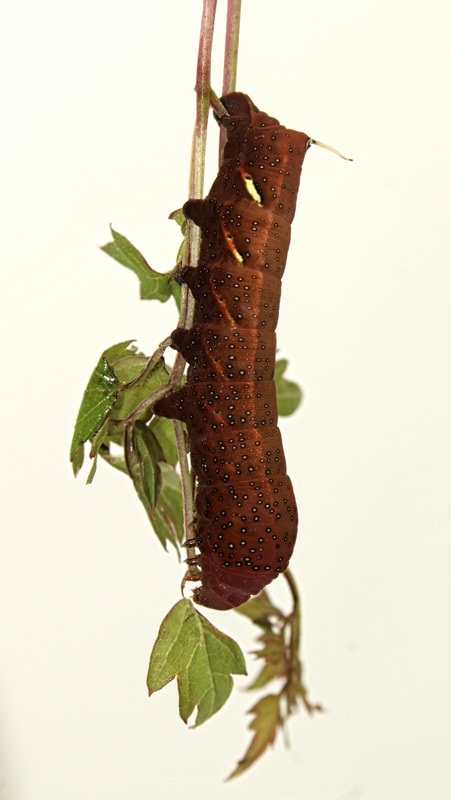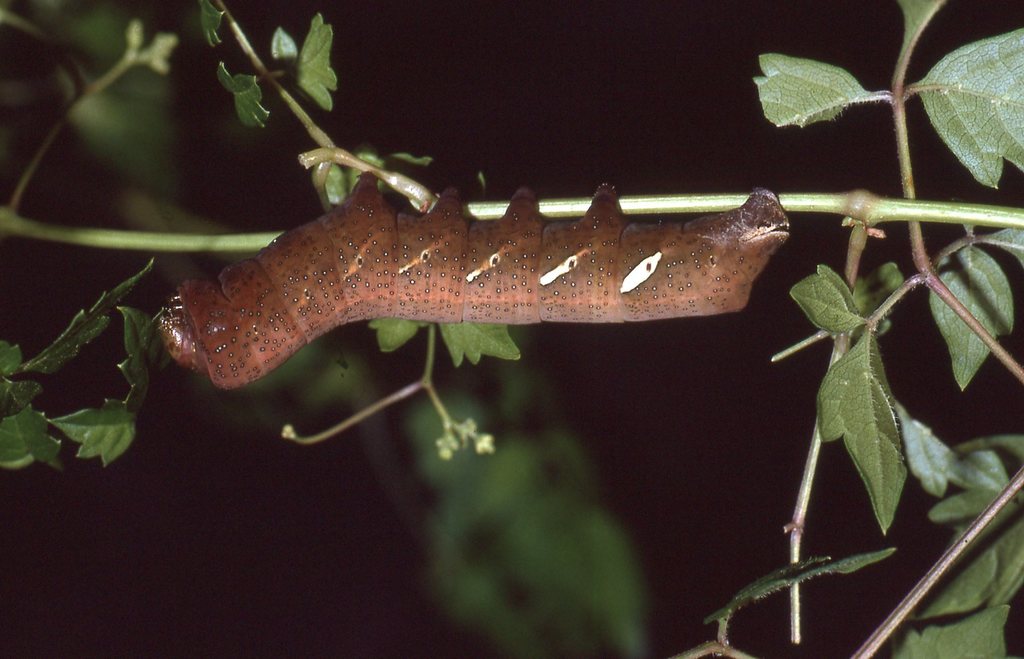|
Common names: Intermediate Sphinx Moth
Ecology and Life History: This moth is active from June through September. This species is attracted to light, though never in large numbers. It is unlikely that bait would be a useful method of attracting this species. This species is not sexually dimorphic, and males and females look identical. Females have a larger, rounder abdomen than males. Eggs are laid on hostplant leaves, likely favoring new growth. Young larvae feed singly, and are likely on the underside of the leaves. This species seems to like vines sprawling over other things like trees or fences. Like other Eumorpha, this species can retract its head and thoracic segments into an enlarged region of the abdominal segments. This species can be either green or brown-red. Habitat and Searching for Larvae: This species feeds on Vitaceous vines. Our records come from Ampelopsis arborea (Peppervine) but the larvae did accept Parthenocissus quinquefolia (Virginia Creeper) briefly in captivity. Larvae are usually found halfway up the vine. A 2nd instar was found approximately 5-6’ off the ground, and a final instar was found about a foot off the ground (18). This is a moth of the gulf coast, it likely inhabits pine forests, suburban yards, meadows, wetlands, and edge habitat where it’s hostplant grows. Our records are from a pine forest with scattered Ampelopsis plants through the habitat (18). Larvae make considerable damage to host in the final instar, making them easier to find (18). This species can be found throughout the warm months. Our records are from August, but it likely lingers into October. First instars are likely active in June and July as well. It is unknown if this species fluoresces under UV light, it is likely that it does. Rearing Notes: Methods for obtaining eggs from this species are currently unavailable. It is likely that this moth needs a large flight cage, ample hostplant, and plenty of food however. This species does seem to like to stick with a particular plant. They can presumably be found on most Vitaceous plants, but are hesitant to switch. In captivity, we had a third instar eat some Parthenocissus quinquefolia, before ultimately switching back to Ampelopsis arborea. Like many Sphingidae, this species is susceptible to parasitoids. They are fairly humidity tolerant, but dislike their rearing conditions being wet. Crowding is an issue for this larva, it is recommended to rear them singly if using tupperware. Sleeving is a good method for rearing and an entire vine can be placed in a sleeve. Multiple larvae can be reared in a sleeve together, and final instars should be removed before pupation Pupation can be achieved by using the paper towel method (outlined in the general information tab) or using loose soil. Hostplants: Click here to load this Caspio Cloud Database
Cloud Database by Caspio |
Adult Description:
This is a medium (38-47mm FW length) green-brown moth with a large dark patch in the basal area of the wing (2). This species can be easily confused with Eumorpha pandorus. The dark rectangular patch in this moth is relatively brown and has a convex distal edge; the thin dark subterminal line in the apex of the forewing is scalloped in this species as opposed to being more wavy in Eumorpha pandorus (2, 13, 14). Larval Description: L2: The larva is small, smooth, and has a black and white bicolored horn. The ground color is usually green, with ample black and white speckling. There are two white dorsal lines that run the length of the larva. L3: At this stage, the larva can be green or red in color. There is ample speckling and the horn is solidly colored. There are some visible white patches along the abdominal segments, usually 5-7, generally they are more visible as you progress toward the caudal horn. L5: Larva is very smooth, generally red/green/brown in color, there is a white horizontal line above the spiracles on the side of the larva running the length of the larva. There is a thick subdorsal line which helps separate this species from other Eumorpha species. Much like Eumorpha pandorus and Eumorpha achemon, this species has various white patches on the abdominal segments, usually ranging between 5-7 visible patches. |
The gallery to the left contains photos of Eumorpha intermedia adults. If you have a photo that you would like to submit to us, please contact us.
The gallery to the right contains photos of Eumorpha intermedia larval and pupal stages. If you have a photo that you would like to submit to us, please contact us.
The gallery to the right contains photos of Eumorpha intermedia larval and pupal stages. If you have a photo that you would like to submit to us, please contact us.
